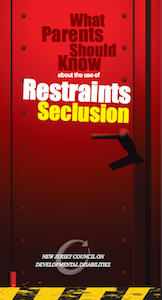Does the school system need parental consent to restrain a student with autism?
He has never had to be restrained before. He does not communicate well, but he is not a danger at all. They restrain him for silly reasons.
A Dangerous Intervention
The frustrating reality for children who cannot communicate well is that they are constantly misunderstood.
Restraint is a dangerous intervention that can lead to injury, trauma, or death in children. You are wise to be concerned and to learn what your rights and your child’s rights are.
The special education law, IDEA 2004, requires the use of functional assessments of behavior and positive behavior support plans to address behavior challenges.
Open your law book, Wrightslaw: Special Education Law, 2nd Edition and start with these statutes and regulations: 1414(d)(3)(B) 1415(k) 34 CFR §300.324(a)(2)(i) 34 CFR §300.530(f)
Send a “No Restraint” Request
Write a letter to the Director of Special Education in your school or district. Note your concerns and that –
you have not authorized and will not consent to any activity that involves physically or mechanically restraining my child while at school or going to and from school
You will find a sample letter requesting “no restraint” here.
Get Your State Regulations
You must research your state and local policies and guidelines regarding restraint and seclusion. Search these documents for information about when restraint is allowed and the requirements for parent consent.
Call your state Department of Education and ask for information and the state policy on parent consent.
You’ll find your state DOE, contact information, and state regulations on the Yellow Pages for Kids with Disabilities.
 The NJ Council on Developmental Disabilities answers questions about What Parents Should Know about the Use of Restraints and Seclusion.
The NJ Council on Developmental Disabilities answers questions about What Parents Should Know about the Use of Restraints and Seclusion.
This booklet includes information (page 8) about informed parent consent and advised that “A school district is required to continue providing a free and appropriate public education to your child even if you refuse to consent to the use of restraints.”
A sample letter for “no authorization” and “no consent” is on page 10.
Find out if there is a similar publication in your state.
US Department of Education Secretary has encouraged the Council of Chief State School Officers (CCSSO)
to develop or review and, if appropriate, revise their State policies and guidelines to ensure that every student in every school under their jurisdiction is safe and protected from being unnecessarily or inappropriately restrained or secluded.
He also urged them to publicize these policies and guidelines so that administrators, teachers, and parents understand and consent to the limited circumstances under which these techniques may be used, and ensure that parents are notified when these interventions do occur.
For more information, reports, and resources please go to Abuse, Restraint and Seclusion in School and Behavior Problems and Discipline.
Another resource about restraint and seclusion is How Safe is the Schoolhouse (July 2019).
This report provides an overview of state laws and a more detailed description of individual state law and policy providing protections against restraint and seclusion.





Wow your comments are very one sided.
You need to think about the other children with special needs. Is the unruly behavior endangering them or the staff ?
I can understand concerns about abuse, but when that is not the issue, but safety for staff, transportation, other children, etc. Then the trained professionals should have a right to mandate/require a safety restraint vest.
Endangering the safety of others in the name of special needs laws, means a loss of people with such big hearts.
What is the statute of limitations to sue a school district if a child was restrained from school then suspended?
They vary. In many cases, the statute of limitations depends on the SOL in your state. Expect to go through the special ed due process procedures before you can successfully bring a lawsuit under Section 504/ADA.
Urge you to consult with an attorney who has expertise in IDEA cases before starting down this road.
I put in my sons IEP no restraint and I meant that. However the school feels they can do what they want to do. They restrain him for everything. His teacher restrains him so he will not get up. He is to sit at his desk all day facing the wall so he cannot see the board. He is separated from peers so there is no interaction with them at all. What can I do to get the school to stop the restraining of my son?
An autistic child I work with was put in private placement in Virginia because the public school system could not accommodate him. This private school boasted about their ABA program to service the autistic population. Shortly after he began school he reported that he was put in a seclusion room and mom began to notice that he was coming home with cuts and bruises on his body. This child is generally not aggressive and can usually be redirected verbally. When mom began to express concerns and reported this to CPS, the school kicked the student out of the program because they reported that mom refused to allow them to use the seclusion room. Since being kicked out of the school he has not been serviced according to his IEP and has been home for over 2 weeks. What can be done in this case?
I hope someone can give you more specific help, but I have a few comments –
– I hope the parent documented every scratch, cut and bruise.
– In my opinion (supported by most people in my field) restraints are ONLY appropriate when the safety of the person or the safety of other’s is at risk – and then there are very strict rules about using restraint.
– EVERY parent/guardian needs to be informed and consent to this.
– ABAI still considers restraint and seclusion acceptable practice – I can’t do their statement justice – so read it here: https://www.abainternational.org/about-us/policies-and-positions/restraint-and-seclusion,-2010.aspx
– USDOE, Medicaid and other health insurance companies have completely FAILED our children by considering only ABA as a “treatment” for autism.
How do you feel about the police being involved with your child only to find out there was excessive force used at school without your knowledge?
I have worked in health care. We had to remove restraints in 1990. It is unlawful to restrain patients. I would imagine it is unlawful to restrain autistic students as well. review the state law on restraint and seclusion as stated above. I went to due process over this, and look at your options to make sure your child has a safe person who can supervise him/her at all times. These laws are for the general public, and most schools do not have the funds, or staffing to deal with some of these behaviors. I truly believe 1:1 for the most sensitive persons, who need to know there is someone they can trust in your absence as they assimilate slowly into the “mainstream”: of life. wrap around wrap around wrap around. your child’s safety is more important than your school’s policy. Trust instincts
A teacher held a 9 year old boy in her lap. He was naked and she was restraining him for over 30 minutes. Because he was tesistant her hands ends up close to his genitals. Is this legal?
It is always best to use a cover or blanket, some type of drape for privacy in dealing with a client. Reading this blog, there is such a crossover from teaching to nursing. Therapeutic staffing and behavioral support needs to deal with these incidents.unless the teacher is at liberty to work in this capacity.
Who is trained in teaching to deal with this behavior? Teachers are trained to teach.